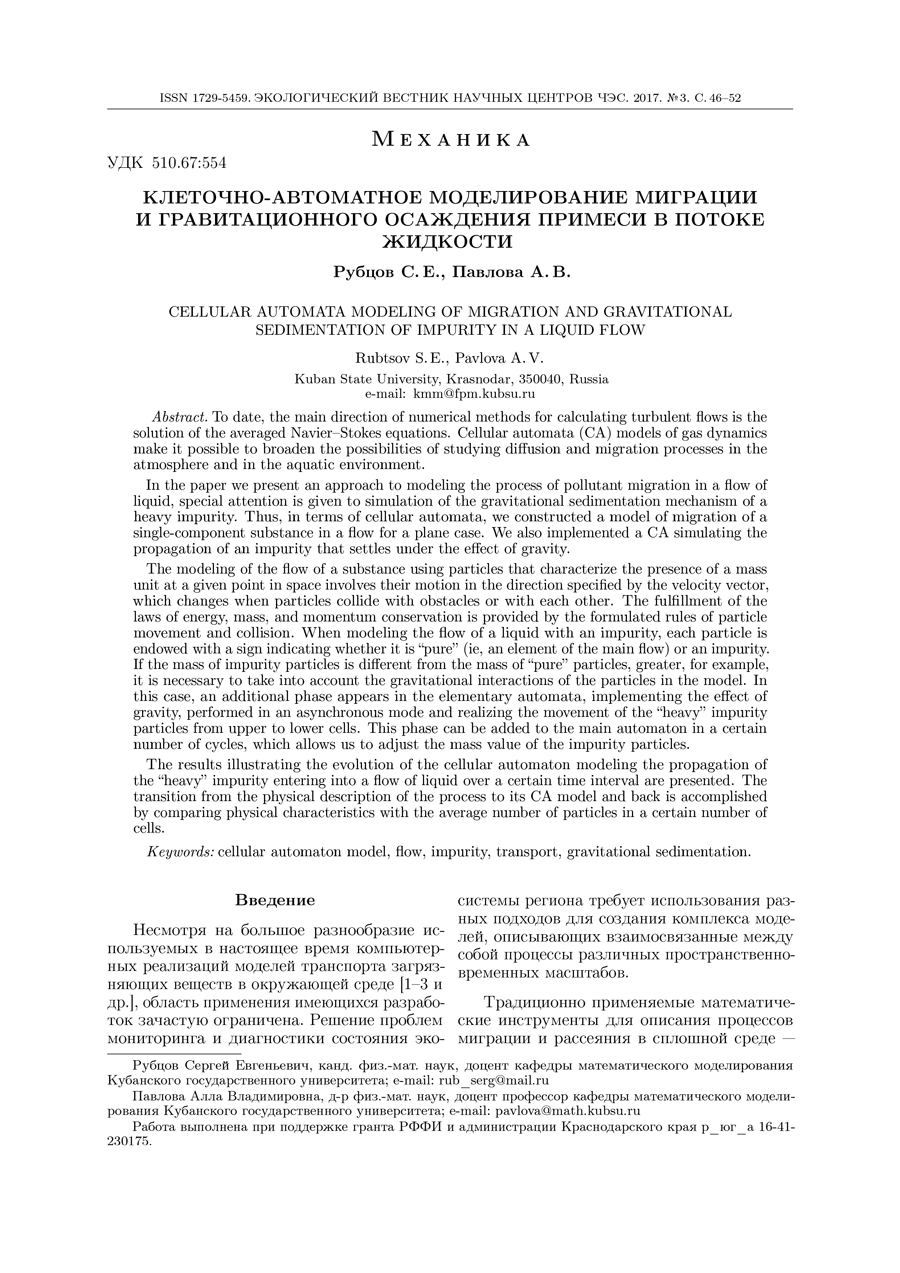Cellular automata modeling of migration and gravitational sedimentation of impurity in a liquid flow
UDC
510.67:554Abstract
To date, the main direction of numerical methods for calculating turbulent flows is the solution of the averaged Navier-Stokes equations. Cellular automata (CA) models of gas dynamics make it possible to broaden the possibilities of studying diffusion and migration processes in the atmosphere and in the aquatic environment. In the paper we present an approach to modeling the process of pollutant migration in a flow of liquid, special attention is given to simulation of the gravitational sedimentation mechanism of a heavy impurity. Thus, in terms of cellular automata, we constructed a model of migration of a single-component substance in a flow for a plane case. We also implemented a CA simulating the propagation of an impurity that settles under the effect of gravity. The modeling of the flow of a substance using particles that characterize the presence of a mass unit at a given point in space involves their motion in the direction specified by the velocity vector, which changes when particles collide with obstacles or with each other. The fulfillment of the laws of energy, mass, and momentum conservation is provided by the formulated rules of particle movement and collision. When modeling the flow of a liquid with an impurity, each particle is endowed with a sign indicating whether it is "pure" (ie, an element of the main flow) or an impurity. If the mass of impurity particles is different from the mass of "pure" particles, greater, for example, it is necessary to take into account the gravitational interactions of the particles in the model. In this case, an additional phase appears in the elementary automata, implementing the effect of gravity, performed in an asynchronous mode and realizing the movement of the "heavy" impurity particles from upper to lower cells. This phase can be added to the main automaton in a certain number of cycles, which allows us to adjust the mass value of the impurity particles. The results illustrating the evolution of the cellular automaton modeling the propagation of the "heavy" impurity entering into a flow of liquid over a certain time interval are presented. The transition from the physical description of the process to its CA model and back is accomplished by comparing physical characteristics with the average number of particles in a certain number of cells.
Keywords:
cellular automaton model, flow, impurity, transport, gravitational sedimentationAcknowledgement
References
- Marchuk G.I. Matematicheskoe modelirovanie v probleme okruzhajushhej sredy [Mathematical modeling in environmental problem]. Moscow, Nauka Pub., 1982, 320 p. (In Russian).
- Penenko V.V., Alojan A.E. Modeli i metody dlja zadach ohrany okruzhajushhej sredy [Models and methods for environmental objectives]. Novosibirsk, Nauka Pub., 1985, 245 p. (In Russian).
- Aloyan A.E. Modelirovanie dinamiki i kinetiki gazovyh primesej i aehrozolej v atmosphere [Modeling of dynamics and kinetics of gas impurities and aerosols in the atmosphere]. Moscow, Nauka Pub., 2008, 415 p. (In Russian)
- Fon Nejman Dzh. Teorija samovosproizvodjashhihsja avtomatov [The theory of self-reproducing automatas]. Mosccow, Mir Pub., 1971, 384 p. (In Russian)
- Boccara N. Reaction-Diffusion complex systems. Berlin, Springer, 2004. 397 p.
- Vanag V.K. Dissipativnye struktury v reakcionno-diffuzionnyh sistemah. Jeksperiment i teorija [Dissipative structures in reaction-diffusion systems. Experiment and Theory]. Izhevsk, IKI Pub., 2008, 300 p. (In Russian)
- Bandman O. Mapping physical phenomena onto CA-models. In: AUTOMATA-2008. Theory and Applications of Cellular Automata. London, Luniver Press, 2008, pp. 381-397.
- Bandman O. Parallel Simulation of Asynchronous Cellular Automata Evolution. Proc. of 7$^\text{th}$ Int. Conference on Cellular Automata, for Research and Industry (ACRI 2006), 2016, Vol. 4173 of LNCS. Springer, pp. 41-47.
- Bandman O.L. Invarianty kletochno-avtomatnyh modelej reakcionno-diffuzionnyh processov [Invariants Cellular Automaton models of reaction-diffusion processes]. Prikladnaja diskretnaja matematika [Applied discrete mathematics], 2012, no. 3, pp 108-120. (In Russian)
- Toffoli T. Cellular Automata as an Alternative to rather than approximation of Differential Equations in Modeling Physics. Physica D, 1984, vol. 10, pp. 117-127.
- Malinetskii G.G., Stepantsov M.E. Simulation of diffusion processes by means of cellular automata with Margolus neighborhood. Computational Mathematics and Mathematical Physics.,1998, vol. 38, no. 6, pp. 973-975.
- Rubcov S.E., Pavlova A.V., Shkurat I.I. O kletochno-avtomatnyh modeljah processa techenija zhidkosti pri nalichii prepjatstvij i primesi [About Cellular automata models of the process flow of the liquid in the presence of obstacles and impurities]. Zashhita okruzhajushhej sredy v neftegazovom komplekse [Environmental protection in the oil and gas sector], 2014, no. 7, pp. 39-44. (In Russian)
- Pavlova A.V., Kalajdin V.V. Ob odnoj modeli rasprostranenija zagrjaznjajushhej primesi ot ploshhadnogo istochnika [On one propagation model contaminant from the area source]. Zashhita okruzhajushhej sredy v neftegazovom komplekse, 2012, no. 2, pp. 18-22. (In Russian).
- Babeshko V.A., Zaretskaya M.V., Evdokimova O.V., Pavlova A.V., Babeshko O.M. Kruglyakova O.P., Kurilov P.I., Terenozhkin A.M., Gendina I.V. Ocenka vlijanija vulkanicheskih i prirodno-tehnologicheskih zagrjaznenij na jekosistemu Azovskogo morja [Assessing the impact of volcanic and natural-technological pollution on the ecosystem of the Sea of Azov]. Zashhita okruzhajushhej sredy v neftegazovom komplekse, 2010, no. 9, pp. 6-12. (In Russian)
Downloads
Submitted
Published
How to Cite
Copyright (c) 2017 Rubtsov S.E., Pavlova A.V.

This work is licensed under a Creative Commons Attribution 4.0 International License.




